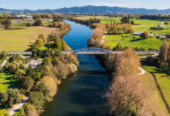
An artist’s impression of the proposed plant.
Global Contracting Solutions say claims a waste to energy plant near Te Awamutu will be a toxic nightmare are scandalous.
The proposed plant was referred to as a toxic nightmare by Valarie Morse in an online meeting last month of Zero Waste Network Aotearoa
The company, CGS, is applying for resource consent to build a plant on Te Awamutu’s Racecourse Road. Paewira would incinerate 150,000 tonnes of waste annually and produce 15 megawatts of power.
Valarie Morse, who chaired last month’s meeting and is the coordinator of Zero Waste’s Regeneration Not Incineration campaign told viewers the plant would pollute the surrounding area and emit mercury, cyanide, cancer causing dioxins, smells, and produce 23 tonnes of ash a day.
But Roger Wilson, the CEO of GCS’ sister company Global Metal Solutions, said incineration was different to conventional burning. Prior to a scrubbing process, high incineration temperatures destroy a number of pollutants that otherwise would be dangerous.
He called Morse’s claims “scandalous.”
“The system has fail-safes and an auxiliary fuel feed. Should the temperature drop below a certain range, the auxiliary fuel feed would kick in to bring that temperature back up,” he said.
Project director Adam Fletcher said the emissions were registered within the application, and emissions were well within New Zealand standards.
The scrubbing process doesn’t remove carbon dioxide, and it is estimated that Paewira would produce eight tonnes of it for every hour of its operation.
Fletcher acknowledged dioxins would be emitted, but “you would get more exposure to dioxins standing in front of your barbeque for two hours than you would from our plant in a year…
“We are going to have 60 staff, and visitors, and people cycling past the plant on a regular basis. We are not going to do something that is going to impact people’s health, we live here too.”
He said that Morse was right about the amount of ash – 23 tonnes a day – that would be produced.
“…but you compare that to the 500 tonnes of material going in per day. And the majority of it is inert ash, as opposed to material that would go into the ground and generate methane for a long time.”
Wilson said ash would not enter the atmosphere, and any leftover metal would be extracted for recycling. The remaining ash could be sent to landfill or used to create materials, such as concrete blocks.
Valarie Morse claimed the burning of tyres would “fill the community with an unbelievable stench,” and the plant would create a significant amount of dust.
Fletcher responded the plant’s high incineration temperature and scrubbing process would prevent those smells from being created.
“Tyres only smell if you burn them outside and alone in a poorly oxygenated area.”
GCS say the facility would be kept under negative air pressure to prevent dust and contaminants leaving, and air would exit the facility through its incinerators.
The Zero Waste meeting was warned the neighbouring Mangapiko stream would be polluted.
“It is quite explicit in our application that we are not touching the river. We are not removing water from the river and the only thing that will go back to the river will be excess rainfall,” Fletcher said.
“We will actually recycle the majority of the water ourselves. Both wastewater and washdown water.”
Fletcher said the plant would not have open dump pits and the recycling process would be fully enclosed.
Sue Coutts, Zero Waste’s director of external affairs, said New Zealand should be more pro-active with its production of waste.
She says instead of investing into waste incineration, money should be spent on making items last longer, recycling efforts, and green energy.
“We have got to invest in things that are going to take us in the right direction, we can’t afford to be careless about this,” she said.
Zero Waste diverted 378 tonnes of waste from landfills in 2020.
Roger Wilson said there was no intention to discourage recycling, or encourage the creation of waste but “we don’t believe that there will ever be zero waste, and this becomes an alternate, disposable option for the future,” Wilson said.
The Ministry of the Environment says 3.5 million tonnes of waste went to class one landfills in the year to June 2021.









